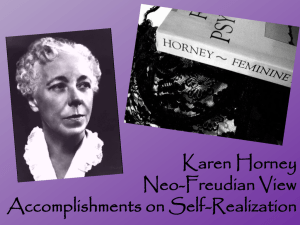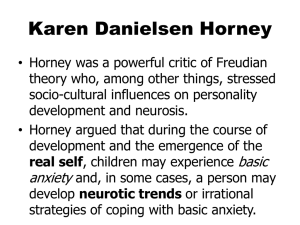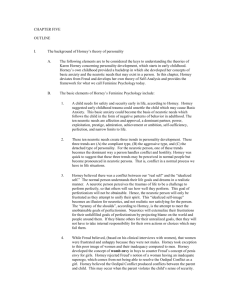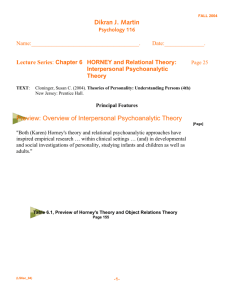Karen Horney & Relational Theory: Interpersonal Psychoanalysis
advertisement
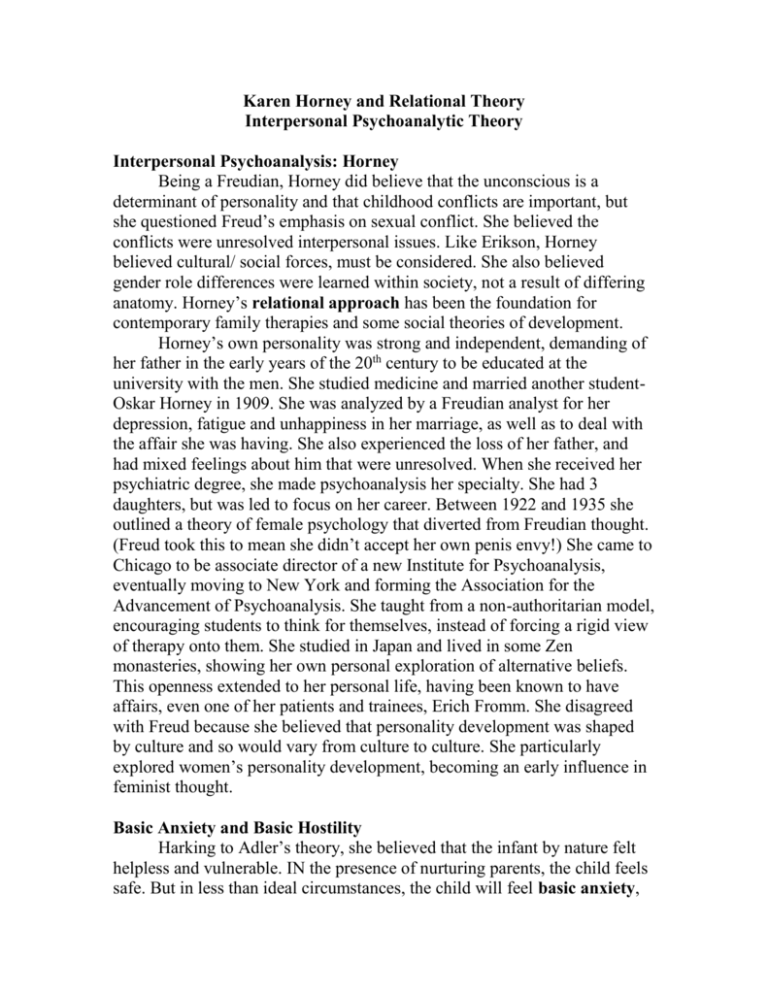
Karen Horney and Relational Theory Interpersonal Psychoanalytic Theory Interpersonal Psychoanalysis: Horney Being a Freudian, Horney did believe that the unconscious is a determinant of personality and that childhood conflicts are important, but she questioned Freud’s emphasis on sexual conflict. She believed the conflicts were unresolved interpersonal issues. Like Erikson, Horney believed cultural/ social forces, must be considered. She also believed gender role differences were learned within society, not a result of differing anatomy. Horney’s relational approach has been the foundation for contemporary family therapies and some social theories of development. Horney’s own personality was strong and independent, demanding of her father in the early years of the 20th century to be educated at the university with the men. She studied medicine and married another studentOskar Horney in 1909. She was analyzed by a Freudian analyst for her depression, fatigue and unhappiness in her marriage, as well as to deal with the affair she was having. She also experienced the loss of her father, and had mixed feelings about him that were unresolved. When she received her psychiatric degree, she made psychoanalysis her specialty. She had 3 daughters, but was led to focus on her career. Between 1922 and 1935 she outlined a theory of female psychology that diverted from Freudian thought. (Freud took this to mean she didn’t accept her own penis envy!) She came to Chicago to be associate director of a new Institute for Psychoanalysis, eventually moving to New York and forming the Association for the Advancement of Psychoanalysis. She taught from a non-authoritarian model, encouraging students to think for themselves, instead of forcing a rigid view of therapy onto them. She studied in Japan and lived in some Zen monasteries, showing her own personal exploration of alternative beliefs. This openness extended to her personal life, having been known to have affairs, even one of her patients and trainees, Erich Fromm. She disagreed with Freud because she believed that personality development was shaped by culture and so would vary from culture to culture. She particularly explored women’s personality development, becoming an early influence in feminist thought. Basic Anxiety and Basic Hostility Harking to Adler’s theory, she believed that the infant by nature felt helpless and vulnerable. IN the presence of nurturing parents, the child feels safe. But in less than ideal circumstances, the child will feel basic anxiety, the feeling of being isolated and helpless in a hostile world. If the environment is neglectful or rejecting, the child becomes angry- feeling basic hostility. It would be very risky for the child to express this hostility, since the child may lose whatever love is there, or be punished, so the child represses the hostility, but it increases the anxiety. A neurotic develops a basic conflict between these contradictory attitudes toward others. The child needs the parents and wants to approach them, but fears, hates or wants to punish them. So neurosis is an interpersonal conflict, not a libidinal conflict with social rules. Three Interpersonal Orientations are the three choices available to the conflicted child: moving toward, moving against, or moving away from the parents. Based on temperament, the child chooses one particular means of managing anxiety. This becomes the characteristic interpersonal orientation. This corresponds to defenses in the animal kingdom: fight, flight or submission. Neurotics can only use the primary defense, but healthy people can choose various responses according to the situation. Moving Toward People: the Self-effacing Solution is the solution chosen in order to seek love and minimize any selfish needs that might interfere with being loved. “To have something good to say about everyone…” This person turns to others for the love and protection they missed in early life. Because dependency is their solution, they must be careful not to alienate others. These types are called compliant types. They are driven by a need for affection, believing “If you love me, you will not hurt me” Others use their submissiveness as though they believe, “If I give in, I shall not be hurt.” Skills this person will develop include: becoming sensitive to others’ needs & feelings, seeking others’ approval, acting in unselfish ways, generous to a fault, romanticizing the sexual relationships & allowing the partner to take control. Women particularly are socialized to feel the need for this type of love. This personality makes few demands on others, plays a “poor me” role that emphasized helplessness and subordination. The inevitable result is low self esteem. Moving Against People: The Expansive Solution is the pattern chosen when neurotics emphasize moving against others, seeking mastery even if it restricts relationship development. “To have enough money or power to impress ‘big shots’ …” This strategy emphasizes master of tasks and power over others, which protects from the vulnerability of helplessness. They are known as aggressive types who believe “If I have power, no one can hurt me.” Power is displayed in dominance, competitiveness, and perfectionism. This can be seen in a militaristic stance by a country’s leaders. These people have problems if they let anyone come close to them in love. Moving Away from People: The Resignation Solution is the way neurotics seek freedom even at the expense of relationship or achievement. “Being free of social obligations…” The sour grapes belief system is the way these people protect themselves- they just do without, assuming that being in relationship will just result in disappointment. These are the detached types and they seem to believe, “If I withdraw, nothing can hurt me” They may become extremely self-reliant, jealous of their privacy. (J.D. Salinger after the publication of The Catcher in the Rye.) These are often creative types, allowing themselves relationships with their creations, but no one else. Healthy vs. Neurotic Use of Interpersonal Orientations The healthy person adopts appropriate orientations towards various people, as is adaptive. Some aggressiveness is necessary to take initiative, make efforts, set boundaries with others, insist on one’s rights, expression of independent views, and planfulness toward a goal. Assertiveness is a mild and appropriate means of accessing power. Submissiveness is appropriate in some circumstances, but excessive dependency is hurtful. Asking for help when needed is appropriate. Horney believed that these styles can lead to physical symptoms- repressed hostility may lead to headaches and stomach problems. Excessive dependency relates to ulcers, asthma, epilepsy and heart disease. High levels of hostility related to coronary heart disease (she was very much ahead of the mind-body movement of the 1980s) These connections have been predicted in controlled studies- finding dependency does predict later illness. Major Adjustments to Basic Anxiety – Horney believed there were 4 major strategies for resolving the basic conflict between helplessness and hostility. They allow coping, although the basic conflict is not resolved. 1. Eclipsing the Conflict: Moving Toward or Against Others which means the neurotic will emphasize helplessness or hostility toward others to deal with the conflict. 2. Detachment: Moving Away from Others which means the neurotic will become detached from others, so the conflict will not be experienced- no relationships, no conflict. 3. The Idealized Self: Moving Away from the Real Self which is to turn away from the real self toward some better idealized self. The real self (the actual self) is the unique personal center of us which leads personal growth- the self that would have developed if we had gotten our dependency needs met as infants appropriately. The child does not have the means to put rejection or neglect into its place and recover self-worth. So the wounded inner child (shades of the 1980s codependency movement) develops a low self-esteem, even feeling alienated from the essential self. As a defense, the child forms the idealized self and tries to measure up: If I am very, very good, I will be lovable. Or: If I impress others with my achievements and power, they won’t hurt me. Or: I don’t need people anyway. This idealized self will drive considerable effort. (I especially liked the way the child victim of sexual abuse may form an idealized self that sees the child as controlling the abusing parent. It retains a sense of control that preserves the self.) The negative consequences of doing this though, are similar to selling one’s soul to the devil. This false pride can lead a person into very destructive patterns. But if the person is confronted on their ordinariness, it produces frightening awareness of conflict. So to maintain the idealized self, people develop and submit to “the tyranny of the shoulds” (Later developed by Ellis in his RationalEmotive Therapy.) These are irrational and unreasonable demands of self that urge us toward the idealized self- but at the expense of connection to and valuing the real self. As people face their inflated goals and feel fears of not obtaining them, they develop anxiety, depression, and general malaise with life. This can descend into suicidal ideation. (Sylvia Plath, the poet, who committed suicide out of her own perfectionism.) Some perfectionists can successful strive for achievement, but when they also suffer mood disorders, anxiety or substance abuse, they put themselves at risk. Some perfectionists feel they are “impostors” and will be found out as such, no matter what level of success they have already had. Horney felt the absolute best was enemy of the good- we should not disregard our accomplishments because they do not meet some ideal of perfection. 4. Externalization: Projection of Inner Conflict – this refers to the tendency to experience internal processes as if they occurred outside oneself or hold these external factors responsible for one’s trials and problems. It includes projection when we assign our own unacceptable tendencies to others rather than integrating them into our own personality development. This is one way of maintaining the perfect self. Secondary Adjustment Techniques are other strategies of reducing anxiety. Like the major strategies, they don’t solve the problem, but allow for management of anxiety. o Blind spots prevent conscious awareness of the conflict between behavior and self-image. People will act selfish but think of themselves as generous. You can’t break this with evidence. They need to maintain the internal fiction in order to continue feeling superior and in control. o Compartmentalization allows the incompatible behaviors to be recognized, but in separate compartments of life. So a person may think s/he is loving in the family, but needs to be aggressive and vicious in business in order to be successful. o Rationalization is “self-deception by reasoning.” We find ways to explain our behaviors to ourselves and others so they seem consistent with socially acceptable images and our own idealized self-image. Often compliant types are very controlling- they just do it by reducing your confidence in your own ability, being over-protective or interfering. They would never accept that they are controlling. They believe they are simply being caring and helpful. Aggressive types will justify their over-weaning control by citing how helpless and incompetent the other person is, so they must “help.” o Excessive self-control is a means of withdrawing from emotional connections with others. These are people who will not openly express themselves if it stirs up conflict, yet they will passively- aggressively ignore what others have asked for, refuse to fight honestly, never show any emotion when there is a genuine difference of opinion. It is a form of superiority designed to protect the person from emotional flooding. Unfortunately, one cannot only shut down negative emotions like rage, one must mute all emotions, making it very difficult for others to feel connected to the other, or like they matter. These people desperately fear their emotions, particularly rage. This may lead to rigid avoidance of sex or alcohol, in the fear of losing control. (Self-control being the safest stance with others.) o Arbitrary rightness is a means for the dominating controller to always feel in control- “we will settle this issue once and for all.” Of course settling the issue means everyone else capitulating to the desires of the controller- since s/he is always right. There is no room for inner doubts and any evidence of challenge of the position is simply dismissed. These people are not open to therapy – what could the therapist know that they do not (or want to know or change.) (George Bush is an example.) o Elusiveness is the opposite of arbitrary rightness. These people do not commit to any opinion or action, because any position might threaten their idealized image. (John Kerry comes to mind.) You can’t pin them down, they have the ability to cloud most issues, seeing benefits to both sides of a question. No matter how dedicated you are to confronting the person’s inexplicable behavior in a situation, they will not accept your evidence. o Cynicism avoids conflict by denying moral values. This person achieves personal goals without being inhibited by moral qualms.(Marquis de Sade.) Cultural Determinants of Development is Horney’s belief that culture determines exactly how we develop. Some cultures develop certain personality styles more than others. This is particularly seen in differences in people within communal cultures vs. independent cultures. It even influences what is considered normal and abnormal. She highlighted the conflict in US society between compulsive need to be first and most successful with our desire to be loved by everybody. (We’re particularly seeing that conflict affecting our society today in our approach to other countries, Iraq in particular.) The book illustrated this conflict with Kurt Cobain’s life. o Gender Roles were outlined by Horney as determined by social messages, not by biology. Social role theory says that cultures define what is masculine and feminine and these components are essential to a sense of self. In Latino cultures, machismo is important to men, forcing dependency by females. Marilyn Monroe’s life shows how the cultural roles of the 1950s forced such inner conflict in her life that she committed suicide. She was the icon of ideal femininity but she felt confined in a role that did not allow her to be creative and intelligent. It resulted in her self-destructiveness in a variety of ways. o Achievement was confined to male roles at the time Horney was writing. Achievment was the measure of the successful man in our society. Research shows that men will tend to perceive situations as competitive more so than females would. Women may even develop a “fear of success” (Horney developed this term) if their careers eclipsed their mate’s. This conflict may erupts from a conflict between competition and need for affection. In Horney’s own life, she broke the mold and developed her career in spite of the demands of her marriage and children. o Social Dominance in our society is defined by dominancy/ power for males and submissiveness/ nurturance for females. The Bem masculinity scale measures Interpersonal Potency and the Bem femininity scale measure Interpersonal Sensitivity. Gender roles affect social power or dominance. Freud believed masochism was a feminine trait, but Horney believed the culture foists masochism on women and calls it desirable. Horney believed masochism was an attempt to secure safety through dependency, lack of needs, & helplessness. Social power does influence the nature of relationships. People use different strategies of influence, depending on whether they feel empowered in the relationship, or not. The more dominating, powerful member of a relationship (economically or personally) will use bullying or overpowering to influence the partner. The less powerful partner will use supplication or manipulation. So power predicts behavior. (This was seen in times of slavery and discrimination as servants knew much more about the master in order to protect themselves and manipulate the little power they had. Servants were hyper vigilant about masters. Masters rarely knew anything personal about the servants.) o Valuing the Feminine Role has to do with what the culture values. Women didn’t have “penis envy”, they had Power envy. Horney believed penis envy was actually a rejection of the feminine role. She even suggested that men were so creative and dominating in the culture because of their jealousy of women’s ability to bring new life into the world! She called this “womb envy” and believed it was a source of male inferiority. She believed that our society valued male characteristics in an effort to diminish the greater feminine strengths of interpersonal connectedness, nurture, & empathy. Society needed to find ways to value these feminine skills. Feminist theory has taken on this idea, but it didn’t come into common thought until the 1980s with Carol Gilligan. Of course women could cling to the idealized self in this area, unselfishly nurturing others to the point that the self is undeveloped. If feminists only value the feminine values, they actually support this undeveloped idealized self for women. In the 1980s this was revealed as one source of codependency- the nurturing woman enabling the alcoholic’s irresponsibility. This prevents growth of either party. o Mental Health and Gender Roles has studied masculinity measures (Bem Sex Role Inventory) to relate to mental health. Those who rated higher in masculinity, of either gender, were found to be mentally healthier. It is not the presence of feminine qualities that are disturbing, but a lack of masculine qualities of assertiveness that are problematic. Clinging to stereotypical gender roles restrict development. Men who idealize the masculine in their lives restrict their emotional growth, develop homophobia, can’t nurture their children, and will neglect their health needs. Feminine stereotypes will lead people to use selfdestructive defense mechanisms such as debasement, depression, helplessness rather than taking charge of their lives effectively when faced with difficulties. So women suffer more depression, men suffer more substance abuse and accidental death and disability. Cross-Cultural Differences are seen in individual vs. communal cultures. Individualist cultures value personal accomplishments, elitism, & affluence. They are often judged as arrogant in the world community, as empire-builders. Their helping behavior is suspect, as they have histories of conquest of other nations (“in their best interest”!) Collectivist cultures value relationships between people and shared, group goals, and mutual responsibilities. They stress conformity, social harmony, group tasks, and family obligations. Unfortunately these cultures are often judged harshly for not developing their natural resources, feeding their people adequately, not developing a sufficient government to progress. These social beliefs influence their members’ self-concept. This can lead to misunderstandings between therapists and members of minority groups. Diversity training for therapists has been encouraged. Therapy engages the whole personality by uncovering the revealing the unconscious strategies the person has been using to deal with neurotic conflict. The outcomes of solely using these strategies are discussed. Then less neurotic ways of resolving the conflict are explored. The idealized self must be seen for what it is and replaced by a real self with value. This did not require spending much time in analysis of childhood memories. Exploring childhood was only necessary to understand unconscious tendencies. Spending too much time on childhood issues was seen as a distraction by the patient from the work of examining neurotic trends. The idealized image must be challenged- shrunken, if you will, to recognize the value of the real self. So the therapist becomes the “shrink!” The ultimate goals are to make changes in the personality, to increase self-responsibility, to become more independent of others, to authentically feel the feelings and to become involved in life. These were later stressed by the humanist therapists. Horney’s theory and methods were 20 years ahead of her times. Self-Analysis could be made if the momentum of growth could be begun in therapy. People can analyze their dreams, write journals, and examine their natural dealings with difficulty. Research has found that journaling about anxiety, etc. can reduce levels of depression, as well as improve health, reduce pain, & improve immune functioning. But dealing with very traumatic memories or experiences alone can produce problems. There are blind spots though, when a person tries to analyze the self without accessing help from professionals with less subjective illusions. Parental Behavior and Personality Development would naturally be a concern of Horney, as she believed early neurosis develops in early childhood, due to imperfect parenting. She believed the ideal family atmosphere to provide warmth, goodwill, and healthy confrontation of the child’s will. That allows the child to develop a healthy sense of belonging, not basic anxiety. Good parents can’t fully love and accept their children unless they examine and solve their own emotional problems. So Horney believed that parents should have help breaking the cycle of neurosis by teaching parents how best to respond to the infants’ emotional expressions. Research does support the fact that neuroticism in parents contributes to abuse of children. Parental acceptance and nonauthoritarian punishment predicts higher ego development in children by age 30. Baumrind developed a paradigm of parenting styles that defines these various styles and weaknesses. Ainsworth and Bowlby developed a theory of attachment styles that contribute to healthy development. The Relational Approach within Psychoanalytic Theory emphasizes interpersonal relationships, particularly with parents. These relational needs are seen as fundamental, with early parental relationships vital, since the young child does not yet have a sense of self. This can be influenced in vital and longstanding ways through early impacts. Early relationships also serve as internal representations of self with others- templates of what to expect in relationships, and response that will unconsciously shape the adult relationships to fit the expectations. (Until we understand the past, we will be doomed to repeat it.) So we read people and behaviors as fitting our expectation of nurturance, rejection, disappointment and they become selffulfilling prophecies. They produce behaviors and reactions in ourselves that may be inappropriate to that person or relationship. (“I am not your father, quit treating me like I am!”) (Freud actually first suggested this with his idea that men seek a partner like their mothers, and women seek one like their fathers.) Relationships are often referred to as object relations, based on the Freudian idea that other people serve as objects of the libidinal desire. (Have you ever felt objectified in a relationship?) Sociopaths have defective object relationships, since they use others for their own selfish purposes. People with borderline personality disorder see others only as they can meet their own needs, so they bond intensely and quickly, and may stalk a person who no longer wants to be in such an emotionally charged relationship. They manipulate others to get their needs met and can’t see the other person as having legitimate needs of his/her own that must be respected. They often attach to people who are not suitable for a relationship – married, or their therapist, or their student (Mary Kay Letourneau) Tests can measure 3 elements of relationship that should mature with age: complexity of representations, capacity for emotional investment, and understanding social causality. Research shows that these relationships are not fixed by age 6, as Freud theorized, but show capacity for development for years into adulthood. People with more benevolent relationships show healthier immune function. The Sense of Self in Relationships – this sense of self begins with early relationships. Children who were not adequately nurtured or loved develop a belief that they lack worth in relationships. This can devolve into borderline personality disorder. These people often describe malevolent early memories in which they were injured and received little help. Other personality disorders relate to early poor parenting. Even good parents can idealize the child to the point that the child feels s/he can never measure up to the grandiose self-image described by the parent. This does not allow the child to fully develop in his/her own individual ways. Our adult relationships do recapitulate the early relationships with parents. If the person was abuse, s/he will often find a partner who will continue the abuse. Even if the partner is not inherently abusive, the person will rarely demand respect of his/her own needs and the balance of power in the adult relationship shifts. The adult child of abuse may act out suicidal ideation, having internalized that s/he is not worthy of love, life goals, needs being met lovingly. (There is even research support that suggests that children who were considered for abortion, yet born, have a heightened suicidal ideation all their lives as a result of internalizing this parental desire to obliterate them.) We often see children who are taken from abusive homes desperately trying to return to these relationships. It seems they need to maintain their relationships with the important object, the parent so desperately that they will obliterate their own needs in order to continue idealizing the parent and hope for further relationship. The fiction of lack of worth of the child may be maintained in order to hang onto the idea that relationship would be possible if only I were worthy of love. Sexual abuse victims often blame themselves for their abuse, even thinking of themselves as seductress, so as to maintain the ideal of the father as loving, not abusive. Later adult relationships are often promiscuous, continuing the fiction that love only comes if you let others objectify you, by being always accepting of others’ use and diminishment. Sometimes sense of self is affected by the loss of a significant other, even if in life that person was difficult and unloving. To resolve unhealthy grief the person must give up the idealized picture of the dead person and reclaim whole value without the person in the relationship. Narcissism is an unhealthy self-focus or self-admiration. Too much selffocus interrupts relationships. It can become a personality disorder in which case it impairs much normal functioning. Narcissists have little empathy for others people, they feel they are special; they deserve all the attention, and admiration, and other people should function as their audience and admirers. They display hostility when asked to remember early shameful experiences, so narcissism is believed to have begun with early shaming experiences as a child. High self esteem is the belief that you are a worthwhile person and it is healthy. They may be more aggressive in service to their goals however. Some people with high self esteem actually have a fragile self-esteem, based on a grandiose image of themselves. They feel vulnerable when challenged. So narcissism is actually not true self-esteem, since it is provoked by any challenge to one’s goodness. People with secure self-worth aren’t so volatile when insulted or challenged. Narcissistic people are easily angered, since their self-esteem is insecure and needs bolstering by others. Attachment in Infancy and Adulthood Infant Attachment- bonds of affection between babies and the mother function to keep the baby near to the parent & protected. Bowlby explored this attachment, seeing the good parent as a secure place for a baby to retreat to when fearful. That secure base should be there for us as we grow- allowing a child to return from exploring the outside world, knowing that s/he will be comforted once home. Ainsworth developed the Strange Room experience to measure infant attachment to mother by observing infants’ responses to strangers. Attachment gives us coping strategies for all our lives. These attachment patterns related to later personality patterns: moving toward, moving away, moving against. Certain parental behaviors correlate to each mode, but childhood temperament makes a difference, as well. o Type A – Moving Away- Resists being comforted o Type B1 – Balance of the 3- Securely attached, explores o Type B4 – Moving Toward- Securely attached, stays near mother o Type C – Moving against- ambivalent toward mother, shows anger toward stranger Adult Attachments and Relationships – attachments in adulthood help us manage emotion and reduce stress. We either develop trust in relationships, or not, and that affects how we relate to others all our lives. Securely attached people show more trust toward partners and resolve conflicts more maturely. Children with mental disorders show insecure attachments and often have parents with insecure attachments. Specific kinds of attachments predispose toward particular disorders: o Dismissing attachment – a person minimizes the emotions around attachment problems- these teens develop conduct disorders or substance abuse (more often Male) o Preoccupied attachment – emphasizes emotions and leads to affective disorders- depression/ anxiety (more often female) o Secure attachment- in adult relationships is seen as committed, staying with an original relationship. o Insecure attachment- shows us in hesitancy about love, divorce in rapid patterns, desperate love, high anxiety, obsessions. (Elizabeth Taylor) o Three-category model Securely attached adults- can get close to others and don’t worry about abandonment or smothering. They are generally higher on extraversion, lower on neuroticism than the other styles. They are less prone to anger and deal with it more maturely. They have more positive views about having children and feel more confident about their abilities to parent. Avoidantly attached adults- have difficulty trusting others, avoid dependency or getting too close to others Anxious-ambivalent adults- worry about not being loved enough by others, and want to get close, but others seem to resist them. The less secure types have problems expressing anger toward partners. They also display more anger around partners & frustration. Longitudinal Studies of Attachment show that disturbed attachment relationships from early life carry over to adulthood. Avoidantly attached women (determined by self-descriptors during college) when followed 30 years later showed up as more likely to be divorced if they had married. They were less close, more defensive and repressive, and less tolerant to stress later in life. Cultural associations with secure attachment were coming from larger family and smaller town. Loss of a parent to death also associated with attachment problems. A 70-year longitudinal study of children whose parents divorced were more likely to be divorced themselves, more likely to die earlier. Secure attachment was negatively affected if a parent had depression, anxiety, or substance abuse, committed suicide, died or was absent for long time. Sexual/ physical abuse affected attachment, neglect, accidents natural disasters, financial setbacks. Those securely attached were more mentally healthy. They were less likely to have depression, phobias, alcohol or drug abuse. They were more likely to marry other securely attached adults. Insecurely attached were more likely to marry other people with similar attachment problems. Parenting has such a long-term influence on development, that improving parenting techniques would improve our entire society in the long run. Children can be taught to interpret parents’ behavior in less internal ways, so they aren’t so afflicted by an inconsistent parent. Therapy can transform negative relationship patterns, so no one who has had an unfortunate early experience should give up on his/her ability to love and relate to others.

